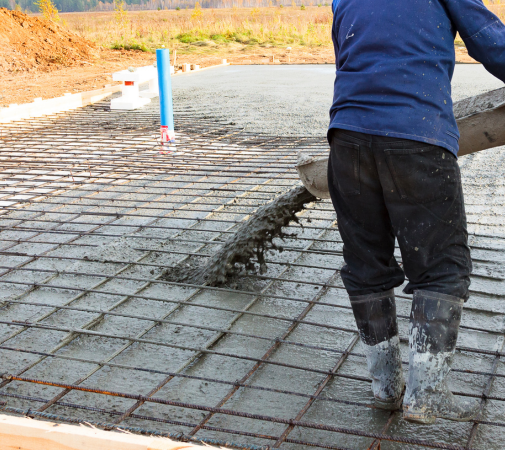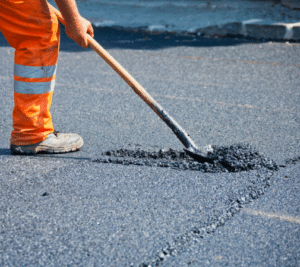Introduction
Site preparation is a vital step in any concrete project, as it lays the foundation for a successful and long-lasting outcome. Whether it is a residential driveway, a commercial parking lot, or a foundation for a building, proper preparation is crucial to ensure efficiency, durability, and the overall quality of the concrete work.
By carefully preparing the site before the concrete contractor starts their job, homeowners and property managers can mitigate potential issues that might arise during or after the project. It allows for better planning and execution, leading to faster construction timelines and improved overall project efficiency.
The significance of site preparation lies in its ability to create a solid and stable base for the concrete. This involves removing any existing material, such as debris, vegetation, or old concrete that may compromise the integrity of the newly poured concrete. Additionally, grading the site to ensure proper drainage and leveling is essential to prevent future problems like pooling water or uneven surfaces.
Moreover, site preparation also involves addressing any underlying issues, such as soil compaction or settlement, which can lead to cracks or shifts in the concrete over time. By identifying and remedying these issues beforehand, homeowners and property managers can avoid costly repairs or replacements in the future.
Proper site preparation before a concrete project is crucial for its success and longevity. It sets the stage for efficient construction, ensures a solid foundation, and helps prevent potential problems down the line. By understanding the importance of these preparatory steps, homeowners and property managers can ensure optimal results for their concrete projects.

Understanding the Scope of Your Concrete Project
Understanding the scope of your concrete project is crucial in ensuring its success and longevity. Before engaging with a concrete contractor, it is important to have a clear understanding of the specific requirements of your project. Different types of concrete projects, such as driveways, walkways, and patios, have varying preparation needs.
For instance, driveways require a sturdy base, proper drainage, and reinforcement for heavy traffic. Walkways may need specific design considerations for aesthetics and to ensure safety and accessibility. Patios may require additional features such as seating areas, fire pits, or barbecue pits. Each project has unique requirements that must be addressed during the preparation phase.
Clear communication with your contractor is essential to understanding the specific requirements of your project. Take the time to discuss your expectations, design preferences, and budgetary constraints with your contractor. This will help them determine the necessary materials, equipment, and techniques needed for your project.
By understanding the scope of your concrete project, you can ensure that the necessary preparations are made to achieve the desired outcome. Proper planning and communication with your contractor will help to minimize delays, reduce costs, and ensure the success and longevity of your concrete project.
Initial Steps for Site Preparation
Site Assessment and Clearing
Before beginning any concrete project, it is crucial to assess the site for any potential issues that could affect the project. This assessment involves a thorough examination of the area where the concrete will be poured. Look for any existing structures, underground utilities, or any other obstructions that could interfere with the project. It is essential to identify these obstacles so that they can be properly addressed and avoided during the construction process. Additionally, take measurements and note the soil conditions to ensure proper drainage and stability.
Clearing the Site:
Once the site assessment has been completed, the next step is to clear the area of any debris, vegetation, or other obstructions. This step is vital as it ensures a clean and stable surface for the concrete to be poured. Remove any loose rocks, tree stumps, or construction debris from the site to prevent interference during the concrete construction process. Clearing the site also involves trimming and removing any vegetation, such as grass or weeds, to provide a smooth and even surface for the concrete. It is crucial to clear the site thoroughly to eliminate any potential problems that could arise during the concrete installation process. By assessing the site and properly clearing it beforehand, homeowners or property managers can ensure a successful and long-lasting concrete project.
Access for Construction
Access for construction is a crucial aspect to consider when preparing a site for a concrete contractor. Adequate access not only ensures smooth operations for workers and equipment but also helps minimize disruption and damage to surrounding areas. Here are some tips to ensure appropriate access:
1. Evaluate Roadways and Entrances: Assess the existing roadways leading to the construction site. Ensure they are wide enough to accommodate construction vehicles and equipment. Identify any potential obstacles such as low-hanging branches or narrow gateways that may limit access.
2. Clear Pathways: Clear the construction pathway from the road to the site entrance. Remove any debris, shrubs, or obstacles to allow easy movement of trucks and machinery. Trim tree branches that hinder the passage of tall vehicles. This will prevent damage to the surroundings and facilitate smooth access for workers and materials.
3. Temporary Roadways: In case the existing access roads are inadequate or easily damaged, consider creating temporary roadways using gravel, mats, or other suitable materials. These temporary roadways can help distribute the weight of heavy machinery and avoid soil compaction or damage to the underlying surfaces.
4. Protect Surrounding Areas: Install shielding materials like plywood or barricades to safeguard nearby landscape elements, sidewalks, or structures from accidental damage during construction activities. This will prevent unnecessary costs and ensure the longevity of these features.
Understanding Soil and Grading Requirements
Soil Type and Preparation
Soil type plays a crucial role in the success of concrete projects, as it directly affects the stability and durability of the structure. Understanding the soil type on the site is essential to determine whether any preparation or modifications are necessary before starting the project.
Different soil types have varying properties such as composition, density, and moisture content. The three main soil types are clay, sand, and silt. Clay soils are characterized by their high plasticity, poor drainage, and tendency to expand and contract with changing moisture levels. Sand soils, on the other hand, are more porous, allowing for better drainage but potentially lacking the cohesive properties required for stable concrete foundations. Silt soils fall somewhere in between, having moderate drainage and cohesion.
Depending on the soil type, several preparation or modification methods may be necessary. For instance, clay soils may require extensive excavation and backfill to remove organic matter and improve compaction. This helps to minimize future settlement issues and the potential for uneven or cracked concrete slabs. Sand soils might benefit from the addition of stabilizers, such as cement or lime, to enhance cohesion and prevent excessive settling.
Overall, understanding the soil type and its specific characteristics is essential for effective soil preparation and modification. By addressing any issues or tailoring the concrete project to the soil conditions, homeowners and property managers can ensure a strong foundation and long-lasting concrete structure.
Grading for Drainage
Proper grading is an essential step in preparing a site for concrete work, as it plays a vital role in ensuring adequate drainage away from the concrete structure and preventing potential water damage. Grading refers to the process of shaping and leveling the ground surface, and it is crucial for creating a stable foundation for the concrete project.
Adequate drainage is crucial to avoid water accumulation around the concrete structure, as excessive moisture can lead to various problems such as cracks, erosion, and even structural failure. Improper grading can result in water pooling around the concrete, which not only compromises its integrity but also increases the risk of moisture-related issues.
To ensure proper grading for effective drainage, homeowners or property managers must assess the existing site conditions. They should consider factors like the slope of the land, the direction of natural water flow, and any potential sources of water infiltration. By understanding these factors, they can design the grading plan accordingly.
The grading plan typically involves creating a gentle slope away from the concrete structure, allowing water to naturally flow down and away from the project area. This slope should be adequate enough to promote efficient drainage without causing erosion or water pooling in other areas. Additionally, it is crucial to address any low-lying areas that could collect water and adjust the grading plan accordingly for proper water diversion.
In conclusion, proper grading is of utmost importance in preparing a site for concrete work. By ensuring adequate drainage away from the concrete structure, homeowners or property managers can mitigate the risks of water damage and achieve a successful and long-lasting concrete project.
Setting Up Forms and Reinforcement
Formwork Setup
Formwork setup is a crucial step in the concrete construction process as it determines the shape and dimensions of the final structure. Forms are temporary structures made of wood, steel, or other materials that are used to contain and shape the concrete until it cures and hardens.
Accurate placement of the forms is of utmost importance to ensure that the concrete takes the desired shape and size. The forms should be set up precisely according to the planned dimensions, contours, and elevations of the project. Any deviation in the formwork setup can lead to irregularities, defects, or even structural failure in the concrete structure.
To achieve accurate placement, proper measuring tools such as levels, plumb bobs, and tape measures should be used. The forms should be securely anchored to the ground or existing structures to prevent movement during the pouring and curing process. Care should also be taken to ensure that the forms are properly aligned, leveled, and braced to withstand the weight and pressure exerted by the wet concrete.
Additionally, formwork setup should consider the desired finish of the concrete surface. Smooth or decorative finishes may require specific types of forms or additional preparations, such as applying form release agents or adding form liners. These details should be communicated to the concrete contractor in advance so that they can be incorporated into the formwork setup.
In conclusion, accurate and precise formwork setup is essential for a successful concrete project. It enables the concrete to take the desired shape, size, and finish, ensuring the longevity and structural integrity of the final structure. Proper planning, measurement, anchoring, alignment, and bracing are key factors in achieving accurate form placement.
Reinforcement Options
When it comes to concrete construction, one critical element to consider is the reinforcement that strengthens the structure and prevents cracking. Concrete alone may be strong, but it is susceptible to tension and can crack under heavy loads or due to temperature variations. That is why reinforcement options such as steel rebar or wire mesh play a crucial role in reinforcing concrete.
Steel rebar is a commonly used form of reinforcement in concrete construction. It consists of steel bars or rods that are strategically placed within the concrete to improve its tensile strength. By adding rebar, the concrete gains resilience against cracking, as the steel bars distribute the loads and help resist tension. This reinforcement option is particularly beneficial for large concrete structures, such as foundations, retaining walls, or driveways.
Another reinforcement alternative is wire mesh. Wire mesh is typically made of intertwined steel wires, forming a grid-like pattern. It is also used to reinforce concrete and prevent cracking. Wire mesh is mainly employed in smaller projects, such as sidewalks, patios, or residential driveways. It helps distribute the load and provides additional support for the concrete, ensuring its durability and longevity.
Both steel rebar and wire mesh are effective reinforcement options in concrete construction. They enhance the concrete’s strength and prevent cracks from forming, contributing to the overall success and longevity of any concrete project. As homeowners or property managers, it is crucial to work closely with a reputable concrete contractor to determine the appropriate reinforcement option suitable for your specific needs.
Planning for Utilities and Other Underground Hazards
Before starting any concrete project, it is crucial to first consider the presence of utilities and other underground hazards. Failing to account for these factors can result in costly damages, delays, and even potential safety hazards.
To avoid such issues, homeowners and property managers should always conduct a thorough check for any utilities that might run beneath the site where the concrete work will take place. This includes electrical lines, gas lines, water pipes, communication cables, and more. Contacting the local utility companies for information regarding the location of these utilities is essential.
It is highly recommended to seek professional assistance in locating and marking utility lines. Professional utility locating services have specialized equipment and trained personnel who can accurately identify underground hazards. They can provide detailed maps and markings that help ensure the safety and integrity of the project.
Accommodating utilities and underground hazards is critical when planning the layout and excavation for a concrete project. Adequate clearance must be maintained to prevent accidental damage during construction. The proper precautions and adjustments should be made to avoid any interference or disruption to utility services.
By diligently planning for utilities and other underground hazards, homeowners and property managers can mitigate risks, maintain the overall safety of the project site, and ensure the successful completion and longevity of their concrete project.
Conclusion
It is crucial for homeowners or property managers to properly prepare their site before hiring a concrete contractor. Thorough preparation is the key to a successful and long-lasting concrete project. By following the necessary steps outlined above, such as evaluating the site condition, clearing debris, and ensuring proper drainage, homeowners can set a strong foundation for the project. This will not only result in a visually appealing concrete structure but also prevent potential issues such as cracking, unevenness, or drainage problems.
Additionally, proper site preparation allows the concrete contractor to work efficiently and effectively, saving both time and money. It also minimizes any disruptions or inconveniences to the residents or occupants of the property during the construction process. By understanding the importance of each step in the preparation process, homeowners can collaborate effectively with the concrete contractor and ensure that their expectations are met.
In summary, investing time and effort in site preparation before hiring a concrete contractor is a wise decision. It sets the stage for a successful project, ultimately leading to a durable and aesthetically pleasing concrete structure that will stand the test of time.



